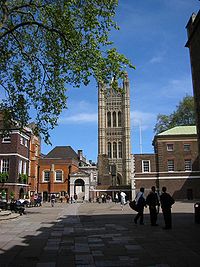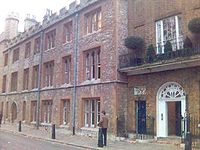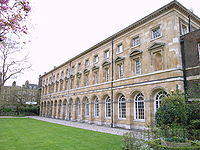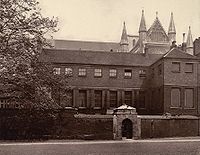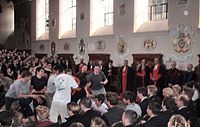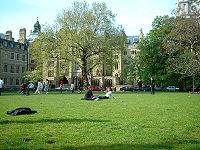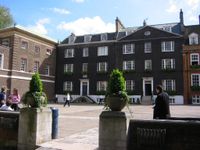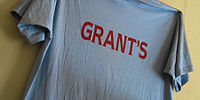- Westminster School
-
For other uses, see Westminster School (disambiguation).
Westminster School 
Motto Dat Deus Incrementum Established 1179
(Refounded in 1560)[1]Type Public School Religion Anglican[2] Head Master Dr. M. S. Spurr[3] Chairman of Governors Very Revd. John Hall, Dean of Westminster[4][5][6] Founder Pope Alexander III (1179)
Elizabeth I (1560)Location Little Dean's Yard
Westminster
London
SW1P 3PF[7][8]
United KingdomLocal authority Westminster Staff 105 Students 747 Gender Boys; Mixed in Sixth Form[9][10] Ages 13 (boys), 16 (girls)–18 Houses College
Grant's
Rigaud's
Busby's
Liddell's
Purcell's
Ashburnham
Wren's
Dryden's
Hakluyt's
Milne'sColours Pink Publication The Elizabethan, Hooke Former pupils Old Westminsters Website westminster.org.uk Coordinates: 51°29′54″N 0°07′42″W / 51.4984°N 0.1284°W
The Royal College of St. Peter in Westminster, almost always known as Westminster School, is one of Britain's leading independent schools,[11] with the highest Oxford and Cambridge acceptance rate of any secondary school or college in Britain. Standing in the precincts of Westminster Abbey[12] in central London,[13] and with a history stretching back to the 11th century, the school's notable alumni include Ben Jonson, Robert Hooke,[14][15] Christopher Wren, John Locke, Jeremy Bentham,[16] Edward Gibbon, Henry Mayhew, A.A. Milne and Tony Benn. The school traditionally encourages independent and individual thinking. Boys are admitted to the Under School at age seven, and to the senior school at age thirteen; girls are admitted only at sixteen.[17] The school has around 750 pupils; around a quarter are boarders, most of whom go home at weekends, after Saturday morning school.[18] It is one of the original nine British public schools as defined by the Public Schools Act 1868. [19]
Contents
History
Although it is likely that schoolboys were taught by monks well beforehand, by 1179 Westminster School had certainly become a public school (i.e., a school available to members of the public from across the country, so long as they could pay their own costs, rather than private tuition provided to the nobility) as a decree of Pope Alexander III required the Benedictine monks of the Abbey at Westminster to provide a charity school to local boys.[20][21] Parts of the school's buildings date back to the 11th century, older than the current Abbey.
This arrangement changed in 1540, when Henry VIII ordered the dissolution of the monasteries in England, but personally ensured the School's survival by his royal charter.[22] The College of St. Peter carried on with forty "King's Scholars" financed from the royal purse. During Mary I's brief reign the Abbey was reinstated as a Roman Catholic monastery. The School occupies a number of the buildings vacated by the monks.
Elizabeth I re-founded the School in 1560,[23][24] with new statutes to select 40 Queen's Scholars from boys who had already attended the school for a year.[25] Queen Elizabeth frequently visited her scholars, although she never signed the statutes nor endowed her scholarships, and 1560 is now generally taken as the date that the school was "founded", although legal separation from the Abbey was only achieved with the Public Schools Act 1868. There followed a scandalous public and parliamentary dispute over a further 25 years, to settle the transfer of the properties from the Canons of the Abbey to the School. Under the Act, the Dean of Westminster Abbey is ex officio the Chairman of the Governors; and school statutes have been made by Order in Council of Queen Elizabeth II. Furthermore the Dean of Christ Church, Oxford and the Master of Trinity College, Cambridge are ex officio members of the school's governing body.[5]
Camden[26] was a headmaster, but Dr Busby,[27][28] himself an Old Westminster, established the reputation of the school for several hundreds of years, as much by his classical learning as for his ruthless discipline of the birch, immortalised in Pope's Dunciad. Busby prayed publicly Up School[29] for the safety of the Crown, on the very day of Charles I's execution, and then locked the boys inside to prevent their going to watch the spectacle a few hundred yards away. Regardless of politics, he thrashed Royalist and Puritan boys alike without fear or favour. Busby also took part in Oliver Cromwell's funeral procession in 1658; when Robert Uvedale, a Westminster schoolboy, succeeded in snatching the "Majesty Scutcheon" (white satin banner) draped on the coffin[30] (it was given to the School by his family two hundred years later). Busby remained in office throughout the Civil War and the Commonwealth, when the school was governed by Parliamentary Commissioners, and well into the Restoration.
In 1679, a group of scholars killed a bailiff, ostensibly in defence of the Abbey's traditional right of sanctuary, but possibly because the man was trying to arrest a consort of the boys. Dr Busby obtained a royal pardon for his scholars from Charles II, and added the cost to the school bills.
During the 16th century the school educated writers including Ben Jonson[31] and Richard Hakluyt; in the seventeenth, the poet John Dryden, philosopher John Locke, scientist Robert Hooke, composer Henry Purcell and architect Christopher Wren were pupils; and in the 18th century, philosopher Jeremy Bentham and several Whig Prime Ministers and other statesmen; recent Old Westminsters include prominent politicians of all parties, and many members of the arts and media.
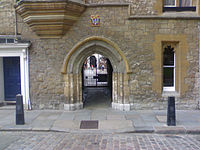 Liddell's arch, the main entrance to Little Dean's Yard.
Liddell's arch, the main entrance to Little Dean's Yard.
Until the 19th century, the curriculum was made up of Latin, Greek, Arabic, and Hebrew, all taught Up School. The Westminster boys were uncontrolled outside school hours and notoriously unruly about town, but the proximity of the School to the Palace of Westminster meant that politicians were well aware of the boys' exploits. After the Public Schools Act 1868,[32] in response to the Clarendon Report on the financial and other malpractices at nine pre-eminent public schools, the school began to approach its modern form. Unusually among the leading public schools, however, Westminster did not adopt most of the broader changes associated with the Victorian ethos of Thomas Arnold, such as the emphasis on team over individual spirit, and the school retained much of its distinctive character. Despite many pressures, including evacuation and the destruction of the School roof during the Blitz, the school also refused to move out of central London along with other prominent schools such as Charterhouse and St. Paul's, and remains in its original location close by the centres of church and state.
Westminster Under School was formed in 1943[33] at the evacuated school, as a distinct preparatory school for day pupils between the ages of 8 to 13 (now 7 to 13). Only the separation is new: for example, in the 18th century, Edward Gibbon attended Westminster from the age of 11. The Under School has since moved to Vincent Square,[34] overlooking the School's playing fields. Its current Master is Mrs. Elizabeth Hill.
In 1967, the first female pupil was admitted to the Upper School, with girls becoming full members in all houses from 1973 onwards.[35] In 1981, a single-sex boarding house, Purcell's, was created again, for girls. In 1997 the school expanded further with the creation of a new day house, Milne's at 6a, Dean's Yard.
In 2005 the school was one of fifty leading private schools guilty of running an illegal price-fixing cartel, exposed by The Times, which had allowed them to drive up fees for thousands of customers.[36][37] Each school agreed to pay a nominal penalty of £10,000 and ex-gratia payments totalling £3 million into a trust designed to benefit pupils who attended the schools during the period in respect of which fee information was shared.[38][39][40] However, Mrs Jean Scott, the head of the Independent Schools Council, said that independent schools had always been exempt from anti-cartel rules applied to business, were following a long-established procedure in sharing the information with each other, and that they were unaware of the change to the law (on which they had not been consulted). She wrote to John Vickers, the OFT director-general, saying, "They are not a group of businessmen meeting behind closed doors to fix the price of their products to the disadvantage of the consumer. They are schools that have quite openly continued to follow a long-established practice because they were unaware that the law had changed."[41]
In 2007, the school responded to an invitation to become the sponsor of Pimlico School, which was due to be rebuilt as an academy but decided not to go ahead. Westminster City Council chose John Nash, a businessman who owns the for-profit Alpha Plus schools group.[42][43][44]
In 2010, the school and Westminster Abbey hosted an event to celebrate the 450th anniversary of the granting of the institution's Royal Charter. Queen Elizabeth II, a guest of the occasion, unveiled a statue of her namesake in Dean's Yard. The Statue of The School's Foundress was created by sculptor and Old Westminster Matthew Spender.
Location
The School is located primarily in the walled precincts of the former mediæval monastery at Westminster Abbey,[45] its main buildings surrounding its private square Little Dean's Yard (known as 'Yard'), off Dean's Yard, where Church House, the headquarters of the Church of England, is situated,[46] along with some of the Houses, the Common Room, the new humanities building Weston's, and College Hall.
Immediately outside the Abbey precincts on Great College Street is Sutcliff's (named after the tuck shop in the building in the 19th century), where Geography, Art,[47] Theology, Philosophy and Classics (Latin and Ancient Greek) are taught. The Robert Hooke Science Centre[48] is further away, just off Smith Square.[49] As part of an expansion programme funded by donations and a legacy from A. A. Milne,[50] the school has acquired the nearby Millicent Fawcett Hall for Drama and Theatre Studies lessons and performances;[51][52] the Manoukian Centre for Music lessons[53][54][55] (both timetabled and private) and recitals; and the Weston Building at 3 Dean's Yard.[56][57] It also often uses St John's, Smith Square as a venue for major musical concerts.
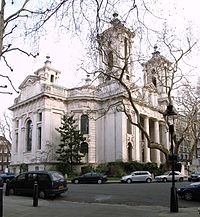 The School often uses St John's, Smith Square as a venue for major musical concerts.
The School often uses St John's, Smith Square as a venue for major musical concerts.
College Garden, to the East of Little Dean's Yard, is believed to be the oldest garden in England, under continuous cultivation for around a millennium.[58] Just beyond rises the Victoria Tower of the Houses of Parliament; the Queen's Scholars have special rights of access to the House of Commons. To the North, the Dark Cloister leads straight to the Abbey, which serves as the School Chapel.[59]
The playing fields are half a mile away at Vincent Square,[60] which Dean Vincent created for the School by hiring a horse and plough to carve 10 acres (40,000 m2) out of the open Tothill Fields. The boathouse is now some way from the school at Putney,[60] where it is also used for the Oxford and Cambridge boat race; but the school's First Eight still returns annually to exercise its traditional right to land at Black Rod Steps of the Palace of Westminster.
Notable buildings
Westminster School, situated in the middle of the UNESCO World Heritage Site of Westminster Abbey, St. Margaret’s, and the Palace of Westminster, has several buildings notable for unique qualities, age, and history.
'College Hall', the 14th-century Abbot's state dining hall, is one of the oldest and finest examples of mediæval refectory in existence, and is still in use for its original purpose every day in term-time; outside of term it reverts to the Dean, as the Abbot's successor.[61] Queen Elizabeth Woodville took sanctuary here in 1483 with 5 daughters and her son Richard, but failed to save him from his fate as one of the Princes in the Tower. In the 1560s, Elizabeth I several times came to see her scholars act their Latin Plays on a stage in front of the attractive Elizabethan gallery, which may have been first erected especially for the purpose.[62][63] Lessons did take place within the hall during the 16th century also.[64]
'College', now shared between the three Houses of College, Dryden's and Wren's, is a dressed stone building overlooking College Garden,[65] the former monastery's Infirmary garden which is still the property of the Collegiate Church of Westminster Abbey. College dates from 1729, and was designed by the Earl of Burlington based on earlier designs from Sir Christopher Wren (himself an Old Westminster).
'School', originally built in the 1090s as the monks' dormitory, is the School's main hall, used for Latin Prayers (a weekly assembly with prayers in the Westminster-dialect of Latin),[66] exams, and large concerts, plays and the like. From 1599 it was used to teach all the pupils, the Upper and Lower Schools being separated by a curtain hung from a 16th century pig iron bar, which remains the largest piece of pig iron in the world.[citation needed] The stone steps and entranceway to School have been attributed to Inigo Jones, and are engraved with the names of many pupils who used to hire a stonemason for the purpose. The panelling "up School" is similarly, but officially, painted with the coats of arms of many former pupils. The original shell-shaped apse at the North end of School gave its name to the Shell forms taught there and the corresponding classes at many other public schools. The current shell displays a Latin epigram on the rebuilding of School, with the acrostic Semper Eadem, Elizabeth I's motto. The classroom door to the right of the Shell was recovered from the notorious Star Chamber at its demolition.
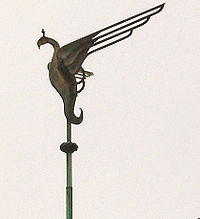 The phoenix which was placed on the roof of school in the 1950s to commemorate the school's resurgence after World War II.
The phoenix which was placed on the roof of school in the 1950s to commemorate the school's resurgence after World War II.
The building lies directly on top of the Westminster Abbey museum, and ends at the start or the Pyx Chamber.
Both School and College had their roofs destroyed during the Blitz by incendiary bombs in 1941. The buildings were re-opened by George VI in 1950.[67]
Ashburnham House, which today houses the library[68] the IT department[69] and the Mathematics Department,[70] was built by Inigo Jones or his pupil John Webb around the time of the Restoration as a London seat for the family who became the Earls of Ashburnham. It incorporates remains of the mediaeval Prior's House, and its garden is the site of the monks' refectory and some of the earliest sittings of the House of Commons. In 1721 when Ashburnham housed the King's and Cottonian libraries, which form the basis of the British Library,[71] there was a disastrous fire, and many of the books and manuscripts still show the marks. After the Public Schools Act 1868 there was a scandalous parliamentary and legal battle between the Abbey and the School, until the School eventually obtained Ashburnham under the Act for £4,000. In 1881 William Morris conducted a public campaign which succeeded in preventing its demolition but failed to save the neighbouring mediaeval buildings. During the Second World War, the library was used for very senior military purposes, and the ground floor as an American officers' club.
Customs
The 'Greaze' has been held "up School" (in the School Hall) on Shrove Tuesdays since 1753:[72][73] the head cook ceremoniously tosses a horsehair-reinforced pancake over a high bar, which was used in the 16th century to curtain off the Lower School. Members of the school fight for the pancake for one minute, watched over by the Dean of Westminster Abbey (as Chairman of the Governors), the Head Master, the whole School and distinguished or even occasionally Royal visitors. The pupil who gets the largest weight is awarded a gold sovereign (promptly redeemed for use next year), and the Dean begs a half-holiday for the whole School. A cook who failed to get the 'pancake' over the bar would formerly have been "booked", or stoned with Latin primers, although that tradition has long lapsed.[74][75][76]
The privilege of being the first commoners to acclaim each new sovereign at their coronation in Westminster Abbey is reserved for the Queen's (or King's) Scholars. Their shouts of "Vivat Regina" ("Long Live the Queen") are incorporated into the Coronation Anthem.[77]
Despite the formal separation from the Abbey,[78] the school remains Anglican, with services in the Abbey attended by the entire school at least twice a week, and many other voluntary-attendance services of worship. The school was expressly exempted by the Act of Uniformity to allow it to continue saying Latin prayers despite the Reformation. Every Wednesday there is an assembly Up School known as Latin Prayers, which opens with the Headmaster leading all members of the school in chanting prayers in Latin, followed by notices in English. The School's unique pronunciation of formal Latin is known as 'Westminster Latin', and descends from medieval English scholastic pronunciation: Queen Elizabeth I, who spoke fluent Latin, commanded that Latin was not to be said "in the monkish fashion", a significant warning upon loyalties between Church and State. A service called 'Little Commem' is given in Latin each year, in which the Queen's Scholars commemorate the school's benefactors, laying pink roses on the tomb of Elizabeth I in Westminster Abbey. In alternate years a much larger service called 'Big Commem' is given in its place, where the Praefectus (the Head Boy/Captain of the Queen's Scholars) lays a wreath of pink roses on the tomb of Elizabeth I. Prospective donors are particularly invited to note the School's gratitude to benefactors. From 2010 "Big Commem" will occur in every other year.
Since the monastic Christmas revels of mediæval times, Latin plays have been presented by the Scholars, with a prologue and witty epilogue on contemporary events. Annual plays, "either tragedy or comedy", were required by the school statutes in 1560, and some early plays were acted in College Hall before Elizabeth I and her whole Council. However, in a more prudish age Queen Victoria did not accompany Prince Albert and the Prince of Wales to the play, and recorded in her diary that it was "very Improper". Today, the play is put on less frequently, any members of the school may take part, and the Master of the Queen's Scholars gives the Latin prologue. The 1938 play caused a diplomatic incident with the German ambassador withdrawing offended by the words 'Magna Germania' figuring in extenso on a map of Europe displayed.
The Queen's Scholars have privileged access to the House of Commons gallery, said to be a compromise recorded in the Standing Orders of the House in the 19th century, to stop the boys from climbing into the Palace over the roofs.
Entry
There are four main points of entry for pupils:
- For the Under School, at ages 7, 8, and 11, judged by a combination of internal exam and interview.[79]
- For the Lower School, at age 13, judged by either Common Entrance, a standardised, national set of exams for entrance to independent schools,[80] for standard entry; or the Challenge, an internal set of exams for scholarship entry; as well as interview.
- For the Upper School, at age 16, judged by subject-specific exams and interviews and conditional upon GCSE results. This is the only point of entry for girls, and only a handful of boys join at this point each year.
As well as the Queen's Scholarships which pay one half of boarding fees, and of which there are normally eight in each year, there are Honorary Scholarships for boys who pass the Challenge and could have been scholars but do not want to board. Stephen Hawking was entered for the Challenge in 1952, but fell ill on the day of the Challenge examination.
Those entering the Lower School also have the opportunity to win scholarships based on musical talent, and bursaries for those whose parents are not able to fund their tuition.
University applications
According to a report by the Sutton Trust, Westminster School had the highest average Oxbridge acceptance rate over the period 2002–2007 of any school at 49.9%[81][82] and had 77 pupils achieving Oxbridge places in 2005.[83][84] It also has an 85.6% (5 year average) acceptance rate into the Sutton 13 elite list of the top 13 universities for research in the UK. The report claimed that, in general, independent schools achieve 16.3% more places at Sutton 13 universities than would be expected on merely from A-level grades, although it has been accepted that module grades were significantly better at Westminster and that the new A* at A-Level should provide more accurate differentiation.[85]
Westminster jargon
Westminster has an unusual system for naming the school years, which can cause confusion to those not familiar with the system.[86]
-
- Year 9: Fifth Form
- Year 10: Lower Shell
- Year 11: Upper Shell (GCSE)
- Year 12: Sixth Form (AS)
- Year 13: Remove (A2)
The Lower and Upper Shell years are named after the shell-shaped alcove up School where they were originally taught; the name has been adopted by several other schools with a Westminster connection.
The first term of the academic year, from September to December, is known as Play Term. This is the term in which the Latin Play used to take place (see Customs). The second term, from January to Easter is the Lent Term. The third term of the academic year, from April to July is the Election Term. This is the term in which new scholars are elected, formerly in place of those examined and elected to the universities.
Other jargon and slang
- Abbey
- When used without an article, refers to the compulsory morning service in the Abbey on Mondays and Fridays;[87] "It's time for Abbey".
- Begging a Play
- Making a request for a Play (qv). The Dean annually begs a play at the Greaze, but other plays may also be begged especially by celebrities or in recognition of notable events in the life of the School.
- The Challenge
- The exam sat by boys applying for scholarships. It was wholly oral until 1855, its name deriving from the practice of a candidate interrupting, or 'challenging' one already speaking.[88]
- Digniora
- An award given to a pupil for an outstanding piece of work. Previously issued to pupils from all years (Vth form - Remove), it is now only given to boys in the lower school (Vth, Lower Shell and Upper Shell). An award of a digniora was once an extremely rare event, normally unwitnessed over the course of a Westminster career. The teacher awarding one would write digniora on the work to be honoured with instructions for the pupil to proceed to his housemaster; his housemaster would then escort the pupil to the Headmaster's study where a beaming head would fish out from a cache of surplus Maundy money a piece of silver coinage. More recently the custom has evolved where pupils who receive one go to the Head of Year to be given a silver threepenny piece, generally from the early 20th century, and once 3 dignioras have been earned they can go and see the Head Master to be given a £10 book token.
- Election
- A year of scholars. The first election are the year 9 scholars, the second election are the year 10 scholars etc. There are usually eight scholars in each of 5 Elections.
- Fields
- Vincent Square. One is always "up Fields". See "Up".
- The Greaze
- Annual pancake fight. See the section on customs.
- Green
- Dean's Yard; The lawn in the middle of Dean's Yard; "The school has a legal right to play football on Green" (always without an article).
- Hurdle
- End of term exams for the Upper School, first coined by the Classics department in the 1970s.
- Mill (obsolete)
- A fight.
- Muzz (obsolete)
- Swot (both noun and verb). This word was still in use in the 1920s and attempts were made to revive it in the 1970s.
- Occupat
- During the annual Anglican confirmation service, non-church goers are confined to their Houses. This is referred to as occupat.[89]
- Order Sheets
- School reports.
- The Pink List
- The list of pupils and members of the Common Room of the school. This exists both as a small pink book (the source of the name) and as a computer database.
- Play
- A day's holiday, especially in conjunction with a notable event. Annual plays are the Queen's Play and the Dean's Play. A recent extraordinary play was the "Pooh Play" in recognition of the School's selling the rights to Winnie the Pooh to the Walt Disney Corporation.[90] The day on which a play is given is usually a Saturday. qv 'Begging a play'.
- Praebendum (plural Praebenda)
- Essentially same as a Digniora, but issued to those boys and girls in the Upper School (VIth and Remove) who submit outstanding pieces of work, or attain well-above average test results.
- Shag (Day)
- Pupils may attend school wearing clothes not specified by the uniform code, but are expected to give to charity if they do so. This is only permitted on certain days; "It's Shag Day on Friday." Compare mufti day. As a verb, it was widely used to mean "play truant", but fell into disuse due to the more widely known modern meaning.
- Smug (obsolete)
- Noun meaning a self-satisfied person. Still in use in early 20th century
- Station
- Sports which are compulsory and held on Tuesday and Thursday afternoon at various times; "He missed Station as he was sick". Originally it meant any compulsory engagement.
- Up (house, School,[91] etc.)
- "Inside" or "to". "You should be up house if you don't have a lesson", "Latin prayers take place up School". Events in Vincent Square are said to be "up Fields", particularly among the Common Room. Exceptions to the rule are that one is never "up College" only "in College", "in Yard" and "on Green".
- Water
- Rowing Station (the Westminster School boat club is based in Putney)[60]
- Yard
- Little Dean's Yard; "He was in Yard" (always without an article). This is also often used to refer to the period after Prep from 9pm to 10pm when boarders are free to entertain themselves in Yard.
Houses
The school is split into 11 houses, some of which are 'day houses' (and only admit day-pupils, those who go home after school), the others having a mix of day-pupils and boarders. The houses are named after people connected to the house or school in various ways — mainly prominent Old Westminsters but also former Head Masters and House Masters. Other than College, Grant's is the oldest house, not only of Westminster but of any public school.
Houses are a focus for pastoral care and social and sporting activities, as well as accommodation for boarders. All the day houses are mixed-sex, and all houses admit girls; only Busby's, Liddell's and Purcell's provide boarding accommodation for girls - the remainder admit day girls only.[92]
Each house has associated colours, which are worn on ties awarded for various (usually sporting) achievement while representing the house. There are also pink-striped ties awarded for achievement while representing the whole school, with the amount of pink denoting the level of achievement. Wren's and Milne's use slightly different colours on house ties from those seen on their shirt.
House Abbr. Founded Named after Colours Pupils Boarding Non-boarding College CC 1560 n/a Dark green Boys Girls Grant's GG 1750 The "mothers" Grant - landladies who owned the property and put up boys in the days before boarding existed, when the School only accommodated Scholars; the oldest house in any of the Public Schools. ■ Maroon on light blue Boys Mixed Rigaud's RR pre-1896 (rebuilt) Stephen Jordan Rigaud ■ Black on orange Boys Mixed Busby's BB 1925 Richard Busby ■ Dark blue on maroon Mixed Boys Liddell's LL 1956 Henry Liddell ■ Blue on yellow Mixed Mixed Purcell's[93] PP 1981 Henry Purcell Pink Girls Girls Ashburnham AHH 1881 The Earls of Ashburnham whose London house is now part of the School ■ Light blue on dark blue None Mixed Wren's WW 1948 Christopher Wren ■ Pink on black (Blue and Maroon used on ties) Dryden's DD 1976 John Dryden ■ Silver on red Hakluyt's HH 1987 Richard Hakluyt[94] ■ Yellow on blue Milne's MM 1997 A. A. Milne ■ Black on orange (Tie uses Red and Yellow) College, the House of the Queen's Scholars (all of whom board), has assigned to it some of the non-boarding girls who enter the School in the VIth form.
Sport ("Station")
 Westminster School Boat Club's boathouse in Putney
Westminster School Boat Club's boathouse in Putney
The School has three Eton Fives courts, located behind Ashburnham House. The school frequently fields pupils as national entries in international competitions in rowing, or "Water", and fencing.
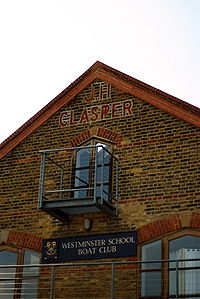 Westminster School Boat Club's boathouse in Putney
Westminster School Boat Club's boathouse in Putney
Westminster School has one of the oldest rowing clubs in the world, located on the River Thames. The Oxford University Boat Club uses Westminster's boat house at Putney as its HQ for the annual Oxford and Cambridge boat race on the Thames. The boathouse was remodelled in 1997, and won a Wandsworth design award in 1999.[95] The school's colour is pink; one suggested origin of this colour is that it was derived from washed-out red shirts worn by rowers. Another rumour is that Westminster rowers raced Eton College for the right to wear pink.[96] The story goes that, at one annual Eton-Westminster rowing race, both crews arrived wearing pink, which was fashionable at the time. The Eton crew bought some light-blue ribbon (which later became the standard Eton colours) to differentiate themselves, but the Westminster crew won the race and the right to wear pink in perpetuity.[97] The premier Leander Club at Henley, founded in London by a number of Old Westminster rowers, later adopted it, although they call the colour cerise.[98] This unusual colour for sportsmen has occasionally provoked violent incidents in recent times,[citation needed] but usually removes any need for "away" kit; the only problems arise when racing against Abingdon School, which also wears pink.
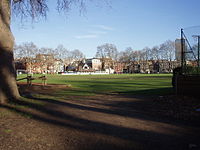 The school playing fields in Vincent Square
The school playing fields in Vincent Square
The School's main sports ground is nearby at Vincent Square,[99][100] but it is limited to football and cricket on the main area and tennis and netball on the courts; it also hosts a playground for Westminster Under School. It is not large enough for all the pupils doing these sports to use simultaneously (the football pitches are made into cricket pitches for the summer). Therefore the school hires and owns other sporting facilities near the school. These include the oldest boating club in the world, an astroturf ground in Battersea, and a fencing centre. 'Green' (Dean's Yard) is also used, as are the 2 school gyms (one in the Abbey Cloisters and one in the Weston's school building) and the three Fives courts, as well as informal "yard cricket", "yard football" and "Scuba Football" played in Little Dean's Yard.
Westminster played in the first school cricket match against Charterhouse School in 1794[101] and from 1796 played cricket against Eton.[102]
Westminster has an historic joint claim to a major role in the development of Association Football,[103] which remains the school's largest sport. During the 1840s at both Westminster and Charterhouse, pupils' surroundings meant they were confined to playing their football in the cloisters,[104] making the rough and tumble of the handling game that was developing at other schools such as Rugby impossible, and necessitating a new code of rules. During the formulation of the rules of Association Football in the 1860s, representatives of Westminster School and Charterhouse also pushed for a passing game, in particular rules that allowed forward passing ("passing on"). Other schools (in particular Eton College and Harrow) favoured a dribbling game with a tight off-side rule. By 1867 the Football Association had chosen in favour of the Westminster and Charterhouse game and adopted an off-side rule that permitted forward passing.[105][106] The modern forward-passing game was a direct consequence of Westminster and Charterhouse Football.
The school currently boasts two OWW professional footballers. Rafe Fletcher, who is at present signed to Conference Premier side Grimsby Town, and Patrick Meade who ended the 2010/2011 season with Peruvian second division team Hijos de Acosvinchos
In August 2009 the school's first XI gained a draw against the Chelsea Academy team. The result was seen as a shock, considering that football has not always been seen as the school's strength, but since then the team has beaten schools normally considered to be of a higher calibre, such as Millfield.[citation needed]
Headmasters
- 2005- Dr Stephen Spurr
- 1998-2005 Tristram Jones-Parry
- 1986-1998 David Summerscale
- 1970-1986 John Malcolm Rae
- 1957-1970 John Dudley Carleton
- 1950-1957 Walter Hamilton
- 1937-1950 John Traill Christie
- -1936 Harold Costley-White
- 1901-1919 Dr James Gow
- 1883-1901 William Gunion Rutherford
- Revd C. B. Scott
- 1846-1855 Henry George Liddell
- 1803-1814 William Carey
- 1788-1802 Dean William Vincent
- 1764-1788 Samuel Smith
- 1753-1764 William Markham
- 1734 (temp acting) John Hinchliffe
- 1695- Robert Freind
- 1638-1695 Dr Richard Busby
- 1593-1597 William Camden
- 1572-1592 Edward Grant
Notable former pupils
The following people were educated at Westminster, amongst about 900 others listed in the ODNB:
- Richard Hakluyt (1553–1616), writer[107]
- Ben Jonson (1573–1637), poet and dramatist[108]
- Arthur Dee (1579–1651), alchemist and royal physician
- George Herbert (1593–1633), public orator and poet[109]
- John Dryden (1631–1700), poet and playwright[110]
- John Locke (1632–1704), philosopher[111]
- Sir Christopher Wren (1632–1723), architect and scientist, co-founder of the Royal Society[112]
- Robert Hooke FRS (1635–1703), British scientist[113]
- Henry Purcell (1659–1695), composer
- Augustus Henry Fitzroy, 3rd Duke of Grafton (1735–1811), Prime Minister
- Charles Wesley (1707–1788), Methodist preacher and writer of over 6,000 hymns[114][115]
- Edward Gibbon FRS (1737 – 1794), historian[116]
- Jeremy Bentham (1748–1832), lawyer, eccentric and philosopher[117]
- Thomas Pinckney (1750–1828), American soldier, politician, and diplomat.
- Charles Cotesworth Pinckney (1746–1825), ADC to Washington 1777, defeated by Jefferson in 1804 in contest for Presidency
- Matthew Gregory "Monk" Lewis (1775–1818), novelist and dramatist[118]
- John Russell, 1st Earl Russell (1792–1878), Prime Minister
- FitzRoy Somerset, 1st Baron Raglan (1788–1855), lost his right arm at Waterloo, C-in-C in the Crimea who is honoured with a statue in Dean's Yard
- Augustus Short (11 June 1802 – 5 October 1883), the first Anglican bishop of Adelaide, South Australia
- A. A. Milne (QS) (1882–1956), author and journalist[119]
- Robert Southey (1774–1843), poet, historian and biographer[120]
- Oliver Lyttelton, 1st Viscount Chandos (1893–1972), Cabinet Minister during World War II, chaiman of the National Theatre Board
- Hossein Ala' (1882–1964), former Prime Minister of Iran
- Sir Adrian Boult (1889–1983), conductor
- Charles William Anderson Scott (1903–1946), pioneer aviator
- Sir John Gielgud (GG) (1904–2000), actor and director[121][122]
- Charles Harvard Gibbs-Smith (1909–1981), Britain's foremost early aviation historian[123]
- Sir Andrew Huxley (b. 1917), Nobel prizewinning physiologist
- Sir Peter Ustinov (1921–2004), actor, writer, director and raconteur[124]
- Tony Benn (born 1925), politician [125]
- Peter Brook (born 1925, LL 1937–1938), theatre director
- Nigel Lawson (born 1932, WW 1945–1950), former Chancellor of the Exchequer, father of Nigella Lawson
- Simon Gray (1936–2008, WW 1949–1954), playwright and diarist[126]
- Andrew Lloyd Webber (born 1948, QS 1960–1965), composer and producer[127]
- Martin Amis (born 1949), novelist
- Stephen Poliakoff (born 1952, WW 1966–1970), director, playwright and television dramatist[128][129]
- Timothy Winter (born 1960), Shaykh Zayed Lecturer in Islamic Studies, Faculty of Divinity, Cambridge University
- Ian Bostridge (born 1964), classical tenor
- James Robbins (GG 1968–1972), broadcaster
- Shane MacGowan (born 1957, AHH 1972–1973), musician
- David Heyman (born 1961), film producer[130][131][132]
- Matt Frei (born 1963, RR 1978–1981), broadcaster [133]
- Lucasta Miller (born 1966), writer and critic
- Helena Bonham Carter (born 1966, LL 1982–1984), actress[134]
- Noreena Hertz (born 1967, CC 1983-85), economist and campaigner
- Nick Clegg[135] (born 1967, LL), Liberal Democrat leader, MP for Sheffield Hallam, Deputy Prime Minister
- Ruth Kelly[136] (born 1968, DD 1984-86), Cabinet minister
- Marcel Theroux (born 1968), novelist and broadcaster[137]
- Joe Cornish (born 1968), broadcaster
- Afshin Rattansi (born 1968), novelist and journalist
- Adam Buxton (born 1969), comedian
- Louis Theroux (born 1970), broadcaster
- Jonathan Yeo (born 1970), artist
- Dido Armstrong (born 1971, WW, 1987–1989), British musician under the name "Dido"
- Martha Lane Fox[138] (born 1973), head of Digital Public Services
- James Reynolds (born 1974), BBC Beijing Correspondent
- Conrad Shawcross (born 1977), artist
- Pinny Grylls (born 1978, HH 1994–1996), documentary film-maker
- Benjamin Yeoh (born 1978), playwright
- Mica Penniman[139] (born 1983, DD 1996–2001) musician under the name 'Mika'
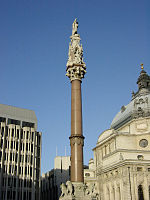 A monument to commemorate former pupils who died in the Crimean War, situated in the Sanctuary, next to the Great West Door of Westminster Abbey
A monument to commemorate former pupils who died in the Crimean War, situated in the Sanctuary, next to the Great West Door of Westminster Abbey
Victoria Cross holders
Six former pupils of Westminster have won the Victoria Cross:
- Edmund Henry Lenon VC (1830–1893) (at Westminster June 1851–1855).
- William George Hawtry Bankes VC (1836–1858) (at Westminster April 1850–1856)
- Nevill Maskelyne Smyth VC (1868–1941) (at Westminster June 1882–1885). He served in the First World War, later Sir Nevill Maskelyne Smyth VC, KCB, (Croix de Guerre (Belgium), Legion d'Honneur (France))
- Arthur Martin-Leake VC and Bar (1874–1953) (at Westminster June 1888–1891), one of only three to receive twice.[140]
- William Hew Clark-Kennedy VC, CMG, DSO & Bar (1879–1961) (at Westminster June 1893–1896).
- Richard Wakeford VC. (1921–1972) (at Westminster June 1934–1940).
See also
- Old Westminsters F.C.
- List of the oldest schools in the world
- List of Victoria Crosses by School
- Queen's Scholar
- Schools' Head of the River Race
- The Old Boys' Network
References
- ^ 1560 - New charter for 'The College' from Elizabeth I[dead link]
- ^ School Overview - Westminster School, schoolsfinder (government website).
- ^ Westminster School | From the Headmaster[dead link]
- ^ As Dean of Westminster he chairs the governors of Westminster School.[dead link]
- ^ a b "Westminster School Intranet". Intranet.westminster.org.uk. http://intranet.westminster.org.uk/lists/whoswho/governors.asp. Retrieved 2011-08-30.
- ^ Imogen Levy and Duck Soup http://ducksoupdev.co.uk+(2006-12-02). "The Very Reverend John R Hall BA Hon DD Hon DTheol FRSA, Dean of Westminster". Westminster Abbey. http://www.westminster-abbey.org/worship/the-clergy/the-very-reverend-john-r-hall-ba-hon-dd-hon-dtheol-frsa,-dean-of-westminster. Retrieved 2011-08-30.
- ^ "Westminster School". BBC News. 15 January 2009. http://news.bbc.co.uk/1/shared/bsp/hi/education/08/school_tables/secondary_schools/html/213_6047.stm. Retrieved 6 April 2010.
- ^ Performance tables, Westminster School. Department for Education, 2005.
- ^ "Westminster School, Westminster, London Area, Independent Schools". Isc.co.uk. http://www.isc.co.uk/school_WestminsterSchool_Westminster.htm. Retrieved 2011-08-30.
- ^ Schools List South, Ogden Trust.
- ^ Briscoe, Simon; Turner, David (12 September 2008). "How to read the great rebellion". Financial Times (London). http://www.ft.com/cms/s/0/3e8fa0d4-7f9a-11dd-a3da-000077b07658.html.
- ^ "Westminster Abbey." Encyclopædia Britannica Online. 9 August 2009.
- ^ This web site is designed and hosted by Biznetix - Your Business Internet Experts (2005-11-10). "Bibliography of Westminster Abbey, 9781843831549, £55.00/$105.00, 4 2005". Boydell.co.uk. http://www.boydell.co.uk/43831546.htm. Retrieved 2011-08-30.
- ^ "A Memorial to Robert Hooke 1635". Roberthooke.org.uk. http://www.roberthooke.org.uk/memorial.htm. Retrieved 2011-08-30.
- ^ Rod Beavon (1999-03-26). "Robert Hooke". Rod.beavon.clara.net. http://www.rod.beavon.clara.net/robert_hooke.htm. Retrieved 2011-08-30.
- ^ "Philosophy in the modern world - Google Books". Books.google.co.uk. 2007-06-15. http://books.google.co.uk/books?id=DESdN6WwN_gC&pg=PA1&lpg=PA1&dq=westminster+school&source=bl&ots=c2vQlWCULw&sig=PDMYQMccix5Q49JIcx74ZstwWN8&hl=en&ei=W6D8SZ_fHt7LjAeq1NiRAw&sa=X&oi=book_result&ct=result&resnum=1. Retrieved 2011-08-30.
- ^ "Westminster School - UK Boarding Schools Guide". Boardingschools.hobsons.com. http://www.boardingschools.hobsons.com/school/Westminster-School-475.html. Retrieved 2011-08-30.
- ^ Schools Guide, The Tatler, 2009.
- ^ "A Guide to Public Schools in the United Kingdom". Publicschools.co.uk. http://www.publicschools.co.uk/guide.htm. Retrieved 2011-08-30.
- ^ "Westminster School". Spartacus.schoolnet.co.uk. http://www.spartacus.schoolnet.co.uk/EDwestminster.htm. Retrieved 2011-08-30.
- ^ Westminster School. (2009). In Encyclopædia Britannica Online. Retrieved 2 August 2009.
- ^ Historical notes on Westminster Schools. Westminster City Council. "After the dissolution of the monasteries in 1540, Henry VIII personally ensured its survival by statute".
- ^ "''Elizabeth I has been credited with founding the Westminster School in 1560''". Luminarium.org. http://www.luminarium.org/encyclopedia/westminsterschool.htm. Retrieved 2011-08-30.
- ^ "''The dean and 12 prebendaries were incorporated by the name of the dean and chapter of the collegiate church of St Peter, Westminster, by Queen Elizabeth, who also placed therein a school.''". Britannica.com. http://www.britannica.com/bps/additionalcontent/14/118165/Westminster-Abbey. Retrieved 2011-08-30.
- ^ "Westminster School in London". Londonancestor.com. http://www.londonancestor.com/leighs/chr-wests.htm. Retrieved 2011-08-30.
- ^ Imogen Levy and Duck Soup http://ducksoupdev.co.uk. "William Camden". Westminster Abbey. http://www.westminster-abbey.org/our-history/people/william-camden. Retrieved 2011-08-30.
- ^ "Dr. Richard Busby, Lord of the Manor & Headmaster of Westminster School". Clutch.open.ac.uk. http://clutch.open.ac.uk/schools/willen99/w_people/Busby/Busby/busby.html. Retrieved 2011-08-30.
- ^ "Dr. Richard Busby's legacy". Clutch.open.ac.uk. http://clutch.open.ac.uk/schools/willen99/w_people/Busby/Bustrus/Bustrus.html. Retrieved 2011-08-30.
- ^ "Up School" is a Westminster term, meaning in or to the ancient school hall.
- ^ Denis Larionov & Alexander Zhulin. "The 'Majesty Scutcheon.' taken from Cromwell's bier. ebooksread.com electronic library". Ebooksread.com. http://www.ebooksread.com/authors-eng/frances-parthenope-verney/memoirs-of-the-verney-family--volume-3-ala/page-28-memoirs-of-the-verney-family--volume-3-ala.shtml. Retrieved 2011-08-30.
- ^ "Ben Jonson: Biography". Theatrehistory.com. http://www.theatrehistory.com/british/jonson001.html. Retrieved 2011-08-30.
- ^ Westminster Abbey, London Footprints.
- ^ "Westminster Under School". Westminsterunder.org.uk. http://www.westminsterunder.org.uk/about.html. Retrieved 2011-08-30.
- ^ "Innovative. Individual. Inspirational". Education UK. 2011-05-27. http://www.educationuk.org/pls/hot_bc/bc_bd_school.page_pls_school_details?x=126739512409&y=0&a=0&b=&psch=1227&psrc=16254576&pseq=1&pinc=1000. Retrieved 2011-08-30.
- ^ {Author} (2009-04-18). "The Old Boys' Network | John Rae | Review by The Spectator". Spectator.co.uk. http://www.spectator.co.uk/books/3539666/tales-out-of-school.thtml. Retrieved 2011-08-30.
- ^ Halpin, Tony (10 Nov 2005). "Independent schools face huge fines over cartel to fix fees". The Times (London). http://www.timesonline.co.uk/tol/life_and_style/education/article588559.ece.
- ^ Calvert, Jonathan (4 May 2003). "Parents may sue on school fee rise 'cartel'". The Times (London). http://www.timesonline.co.uk/tol/news/uk/article877567.ece.
- ^ "The Office of Fair Trading: OFT names further trustees as part of the independent schools settlement". Oft.gov.uk. http://www.oft.gov.uk/news/press/2006/182-06. Retrieved 2011-08-30.
- ^ Clare, John (25 February 2006). "Why did OFT take a pile-driver to crack a nut?". The Daily Telegraph (London). http://www.telegraph.co.uk/news/uknews/1511425/Why-did-OFT-take-a-pile-driver-to-crack-a-nut.html. Retrieved 6 April 2010.
- ^ MacLeod, Donald (9 November 2005). "Elite schools 'breached law' on fees". The Guardian (London). http://www.guardian.co.uk/education/2005/nov/09/schools.uk. Retrieved 6 April 2010.
- ^ "Private schools send papers to fee-fixing inquiry". The Daily Telegraph (London). 01 March 2004. http://www.telegraph.co.uk/news/1455730/Private-schools-send-papers-to-fee-fixing-inquiry.html. Retrieved 15 March 2011.
- ^ Hayes, Dominic (15 October 2007). "Public school's Pimlico bid fails". London Evening Standard. http://www.thisislondon.co.uk/standard/article-23416681-details/Public+school's+Pimlico+bid+fails/article.do.
- ^ Hayes, Dominic (1 October 2007). "Private schools warn over 'rottweiler' Ofsted". London Evening Standard. http://www.thisislondon.co.uk/standard/article-23414557-details/Private+schools+warn+over+'rottweiler'+Ofsted/article.do.
- ^ Benn, Melissa (22 October 2007). "What kind of future is this?". The Guardian (London). http://www.guardian.co.uk/education/2007/oct/23/schools.newschools. Retrieved 6 April 2010.
- ^ "In the precincts are also Westminster School, strongly associated with the Abbey"[dead link]
- ^ "The Corporation of Church House". Churchhouse.org.uk. 1940-06-10. http://www.churchhouse.org.uk/. Retrieved 2011-08-30.
- ^ Westminster School | Activities | Art[dead link]
- ^ "Weston Williamson Architects - Projects". Westonwilliamson.com. http://www.westonwilliamson.com/projects.php?a=westminster_school. Retrieved 2011-08-30.
- ^ Westminster School | Academic Life | Robert Hooke Science Centre[dead link]
- ^ Mount, Harry (12 October 2004). "Trust me: TJP would gain nothing from taking a PGCE". The Daily Telegraph (London). http://www.telegraph.co.uk/comment/personal-view/3611924/Trust-me-TJP-would-gain-nothing-from-taking-a-PGCE.html. Retrieved 6 April 2010.
- ^ Westminster School | Activities | Drama[dead link]
- ^ "Radio 4 Making History - Latest programme". BBC. 2005-10-18. http://www.bbc.co.uk/radio4/history/making_history/making_history_20060110.shtml. Retrieved 2011-08-30.
- ^ "Commercial Case Studies". Smartcomm. http://www.smartcomm.co.uk/casestudies/commercial/westminster-school-smart-technology.aspx. Retrieved 2011-08-30.
- ^ Westminster School | Activities | Music[dead link]
- ^ "London Conducting Workshop Details". London-conducting-workshop.com. http://www.london-conducting-workshop.com/about.htm. Retrieved 2011-08-30.
- ^ Westminster School | Academic Life | Information Technology[dead link]
- ^ [1][dead link]
- ^ Imogen Levy and Duck Soup http://ducksoupdev.co.uk. "College Garden". Westminster Abbey. http://www.westminster-abbey.org/venue-bookings/venues/college-garden. Retrieved 2011-08-30.
- ^ Horan, Tom (2 April 2009). "The Old Boys' Network: a Headmaster's Diaries, 1970-86 by John Rae: Review". The Daily Telegraph (London). http://www.telegraph.co.uk/culture/books/bookreviews/5094502/The-Old-Boys-Network-a-Headmasters-Diaries-1970-86-by-John-Rae-Review.html. Retrieved 6 April 2010.
- ^ a b c Westminster School | Activities | Sports[dead link]
- ^ [2][dead link]
- ^ "Abbey's 'secret' hall opens its doors". BBC News Online (London). 28 February 2002. http://news.bbc.co.uk/1/hi/uk/1845552.stm. Retrieved 6 April 2010.
- ^ "Six hundred years of history". BBC News Online. 28 February 2002. http://news.bbc.co.uk/1/hi/uk/1846818.stm. Retrieved 6 April 2010.
- ^ "Westminster School". Clutch.open.ac.uk. http://clutch.open.ac.uk/schools/willen99/w_education/Westm/Westm.html. Retrieved 2011-08-30.
- ^ Imogen Levy and Duck Soup http://ducksoupdev.co.uk+(2010-10-25). "College Garden". Westminster Abbey. http://www.westminster-abbey.org/visit-us/college-garden. Retrieved 2011-08-30.
- ^ Westminster School Almanack, p. 13.
- ^ The King's Nurseries, John Field, page 101
- ^ Westminster School | Academic Life | The Library[dead link]
- ^ Westminster School | Academic Life | Information Technology[dead link]
- ^ Westminster Almanack, p. 16.
- ^ Cotton Manuscripts, British Library.
- ^ Pancake Day, Wilson's Almanac.
- ^ '1753 - "First recorded 'Pancake Greaze".[dead link]
- ^ Westminster School Pancake Greaze at Answers.com (with bibliography)
- ^ "One Pancake for Fifteen Boys". The New York Times. 2 March 1899. http://query.nytimes.com/mem/archive-free/pdf?_r=1&res=9B03E6DA1730E132A25751C0A9659C94689ED7CF&oref=slogin.
- ^ "English Schoolboys: Recollections of Westminster". The New York Times. 11 July 1903. http://query.nytimes.com/mem/archive-free/pdf?_r=1&res=9B0DEFDD1739E433A25752C1A9619C946297D6CF.
- ^ Imogen Levy and Duck Soup http://ducksoupdev.co.uk. "Guide to the Coronation Service". Westminster Abbey. http://www.westminster-abbey.org/our-history/royals/coronations/guide-to-the-coronation-service. Retrieved 2011-08-30.
- ^ "Westminster School, a public school with ancient and modern buildings nearby, was once the Abbey School."[dead link]
- ^ Westminster School | Entry Levels | Entry at 7/8
- ^ "General Information for Parents". ISEB. http://www.iseb.co.uk/parents.htm. Retrieved 2011-08-30.
- ^ Top 100 Schools, Financial Times Special Report, 8 March 2008.
- ^ Boone, Jon (9 March 2007). "Average state school fails test for Oxbridge". Financial Times (London). http://www.ft.com/cms/s/0/1f62c6b2-ce81-11db-b5c8-000b5df10621.html.
- ^ Freedman, Lisa (14 November 2008). "Competing for grammar school". Financial Times (London). http://www.ft.com/cms/s/0/63cb39fe-b1da-11dd-b97a-0000779fd18c.html.
- ^ Freedman, Lisa (17 November 2006). "An admissions history hard to rewrite". Financial Times (London). http://www.ft.com/cms/s/0/9c87b914-764c-11db-8284-0000779e2340.html.
- ^ Sutton Trust Report, September 2007.
- ^ Westminster School | Studying at Westminster[dead link]
- ^ "almanackP08.qxd" (PDF). https://intranet.westminster.org.uk/almanack/pdf/play08.pdf. Retrieved 2011-08-30.
- ^ In the term before entry, candidates take the Common Entrance or The Challenge (Westminster scholarship examination) to ensure the required standard is met.[dead link]
- ^ "almanackE09.qxd" (PDF). http://intranet.westminster.org.uk/almanack/pdf/election09.pdf. Retrieved 2011-08-30.
- ^ Reynolds, Nigel (3 March 2001). "Disney ready to pay £300m for Winnie the Pooh". The Daily Telegraph (London). http://www.telegraph.co.uk/news/uknews/1324877/Disney-ready-to-pay-300m-for-Winnie-the-Pooh.html. Retrieved 6 April 2010.
- ^ "Full text of "Annals of Westminster School"". Archive.org. http://www.archive.org/stream/annalsofwestmins00sarguoft/annalsofwestmins00sarguoft_djvu.txt. Retrieved 2011-08-30.
- ^ Westminster School | Entry Levels | Entry at 7/8[dead link]
- ^ Formerly Barton Street, and originally a part of Dryden's
- ^ "Hakluyt's Online | About Hakluyt's". Homepages.westminster.org.uk. https://homepages.westminster.org.uk/hakluyts/about.htm. Retrieved 2011-08-30.
- ^ [3][dead link]
- ^ Prospectus, p. 20. "In 1837 there was a boat race against Eton in which each school chose their colours - Westminster chose pink which remains the school's colour to this day."
- ^ Mount, Harry (5 August 2009). "Why real macho men are proud to wear pink". Daily Mail (London). http://www.dailymail.co.uk/femail/article-1204392/Why-real-macho-men-proud-wear-pink.html. "To this day, the strapping male rowing teams at Westminster School wear a fondant-fancy coloured kit; legend has it that they had to beat their arch-rivals Eton in a race in 1837 for the privilege of wearing the fashionable colour."
- ^ "Leander Club - Shop - About". Leander.co.uk. http://www.leander.co.uk/shop/about.asp. Retrieved 2011-08-30.
- ^ Shearer, Paul (16 May 2009). "Palatial surroundings". Financial Times (London). http://www.ft.com/cms/s/2/4f85705a-401d-11de-9ced-00144feabdc0.html.
- ^ Coren, Giles (23 May 2009). "Forget the Ashes This is how to play cricket". The Times (London). http://www.timesonline.co.uk/tol/comment/columnists/giles_coren/article6345675.ece. Retrieved 6 April 2010.
- ^ The Earliest School Match
- ^ Cricket Archive - Eton College v Westminster 1796
- ^ "History of Football - The Global Growth". FIFA.com. http://www.fifa.com/classicfootball/history/game/historygame4.html. Retrieved 2011-08-30.
- ^ Imogen Levy and Duck Soup http://ducksoupdev.co.uk+(2006-06-01). "World Cup kicked off in the Cloisters". Westminster Abbey. http://www.westminster-abbey.org/press/news/news/2006/june/world-cup-kicked-off-in-the-cloisters. Retrieved 2011-08-30.
- ^ Marples, Morris. A History of Football, Secker and Warburg, London 1954, page 150
- ^ FIFA.com - Football Rules are brilliant![dead link]
- ^ "Richard Hakluyt." Encyclopædia Britannica. 2009. Encyclopædia Britannica Online. 09 Aug. 2009 <http://www.britannica.com/EBchecked/topic/252157/Richard-Hakluyt>.
- ^ "Ben Jonson." Encyclopædia Britannica. 2009. Encyclopædia Britannica Online. 09 Aug. 2009 <http://www.britannica.com/EBchecked/topic/306058/Ben-Jonson>.
- ^ "George Herbert." Encyclopædia Britannica. 2009. Encyclopædia Britannica Online. 10 Aug. 2009 <http://www.britannica.com/EBchecked/topic/262706/George-Herbert>.
- ^ "John Dryden." Encyclopædia Britannica. 2009. Encyclopædia Britannica Online. 09 Aug. 2009 <http://www.britannica.com/EBchecked/topic/172371/John-Dryden>.
- ^ "John Locke." Encyclopædia Britannica. 2009. Encyclopædia Britannica Online. 09 Aug. 2009 <http://www.britannica.com/EBchecked/topic/345753/John-Locke>.
- ^ "History - Historic Figures: Sir Christopher Wren (1632–1723)". BBC. http://www.bbc.co.uk/history/historic_figures/wren_christopher.shtml. Retrieved 2011-08-30.
- ^ "Chronology of Robert Hooke". Roberthooke.org.uk. http://www.roberthooke.org.uk/chronolo.htm. Retrieved 2011-08-30.
- ^ "Charles Wesley." Encyclopædia Britannica. 2009. Encyclopædia Britannica Online. 09 Aug. 2009 <http://www.britannica.com/EBchecked/topic/639939/Charles-Wesley>.
- ^ "Charles Wesley," Microsoft Encarta Online Encyclopedia 2009 http://encarta.msn.com/encyclopedia_761576738/Charles_Wesley.html
- ^ "Edward Gibbon." Encyclopædia Britannica. 2009. Encyclopædia Britannica Online. 09 Aug. 2009 <http://www.britannica.com/EBchecked/topic/233161/Edward-Gibbon>.
- ^ "Jeremy Bentham." Encyclopædia Britannica. 2009. Encyclopædia Britannica Online. 10 Aug. 2009 <http://www.britannica.com/EBchecked/topic/61103/Jeremy-Bentham>.
- ^ "Matthew Gregory Lewis." Encyclopædia Britannica. 2009. Encyclopædia Britannica Online. 10 Aug. 2009 <http://www.britannica.com/EBchecked/topic/338188/Matthew-Gregory-Lewis>.
- ^ Milne, Alan Alexander in Venn, J. & J. A., Alumni Cantabrigienses, Cambridge University Press, 10 vols, 1922–1958.
- ^ "Robert Southey." Encyclopædia Britannica. 2009. Encyclopædia Britannica Online. 09 Aug. 2009 <http://www.britannica.com/EBchecked/topic/556936/Robert-Southey>.
- ^ "Sir John Gielgud." Encyclopædia Britannica. 2009. Encyclopædia Britannica Online. 09 Aug. 2009 <http://www.britannica.com/EBchecked/topic/233344/Sir-John-Gielgud>.
- ^ "John Gielgud," Microsoft Encarta Online Encyclopedia 2009 http://encarta.msn.com/encyclopedia_761555090/Gielgud_Sir_(Arthur)_John.html
- ^ Chambers Biographical Dictionary. Chambers Harrap Publishers Ltd. 2007. http://www.credoreference.com/entry/chambbd/gibbs_smith_charles_harvard. Retrieved 26 May 2011. Hosted by Credo Reference.
- ^ "Sir Peter Ustinov." Encyclopædia Britannica. 2009. Encyclopædia Britannica Online. 09 Aug. 2009 <http://www.britannica.com/EBchecked/topic/620440/Sir-Peter-Ustinov>.
- ^ "Tony Benn: End of an era". BBC News. 10 March 2001. http://news.bbc.co.uk/1/hi/uk/1209497.stm. Retrieved 6 April 2010.
- ^ "Simon Gray." Encyclopædia Britannica. 2009. Encyclopædia Britannica Online. 09 Aug. 2009 <http://www.britannica.com/EBchecked/topic/242639/Simon-Gray>.
- ^ Moore, Charles (6 July 2009). "Shining a light on the magic of the coronation in Westminster Abbey". The Daily Telegraph (London). http://www.telegraph.co.uk/comment/columnists/charlesmoore/5760400/Shining-a-light-on-the-magic-of-the-coronation-in-Westminster-Abbey.html. Retrieved 6 April 2010.
- ^ "Stephen Poliakoff," Microsoft Encarta Online Encyclopedia 2009 http://encarta.msn.com/encyclopedia_761581203/stephen_poliakoff.html
- ^ Wroe, Nicholas (28 November 2009). "A life in drama: Stephen Poliakoff". The Guardian (London). http://www.guardian.co.uk/culture/2009/nov/28/stephen-poliakoff-interview-nicholas-wroe. Retrieved 6 April 2010.
- ^ Interview by Michael White - July 16, 2009 00:00 EDT (2009-07-16). "‘Harry Potter’ Producer Ignored First Rowling Book: Interview". Bloomberg.com. http://www.bloomberg.com/apps/news?pid=20601088&sid=aMu4Nu.caxAM. Retrieved 2011-08-30.
- ^ "Making Harry Potter magic - Norwalk News - The Hour - Norwalk's Newspaper". The Hour. http://www.thehour.com/story/471973. Retrieved 2011-08-30.
- ^ "His Wizard Connection". Baltimore Sun. 2011-07-17. http://www.baltimoresun.com/entertainment/movies/bal-ae.mo.potter17jul17,0,3585263.story. Retrieved 2011-08-30.
- ^ "Matt Frei: Aiming for the White House". The Independent (London). 26 May 2008. http://www.independent.co.uk/news/media/matt-frei-aiming-for-the-white-house-834276.html. Retrieved 6 April 2010.
- ^ "Helena Bonham Carter Biography - Yahoo! Movies". Movies.yahoo.com. http://movies.yahoo.com/movie/contributor/1800018966/bio. Retrieved 2011-08-30.
- ^ Oliver, Jonathan (14 September 2008). "Nick Clegg may send sons to private school". The Times (London). http://www.timesonline.co.uk/tol/news/uk/education/article4748815.ece. Retrieved 6 April 2010.
- ^ "Profile: Ruth Kelly". BBC News. 24 September 2008. http://news.bbc.co.uk/1/hi/uk_politics/6241685.stm. Retrieved 6 April 2010.
- ^ "Marcel Theroux - More than just a family affair". The Independent (London). 16 August 2001. http://www.independent.co.uk/news/people/profiles/marcel-theroux--more-than-just-a-family-affair-665759.html. Retrieved 6 April 2010.
- ^ "Martha my very dear". BBC News. 2 March 2000. http://news.bbc.co.uk/1/hi/business/664210.stm. Retrieved 6 April 2010.
- ^ BBC - Music - Mika[dead link]
- ^ Westminster School Development Office, (2005), The Elizabethan Newsletter 2004/2005, page 4, (Westminster School)
Further reading
- Tony Trowles (2005). A Guide to the Literature of Westminster Abbey, Westminster School and St. Margaret's Church 1571–2000. Boydell Press.
- John Rae (1994). Delusions of Grandeur: A Headmaster's Life. HarperCollins.
- John Field (1986). The King's Nurseries: The Story of Westminster School (2nd edition). James & James. ISBN 0-907383-01-7.
- Lance Bertelsen (1987). The Nonsense Club: Literature and Popular Culture, 1749–1764. Oxford: Clarendon Press. ISBN 0198128592.
- John Dudley Carleton (1965). Westminster School: A History (revised edition). R. Hart-Davis.
- Lawrence Edward Tanner (1934). Westminster School: A History. Country Life.
- Reginald Airy (1902). Handbooks to the great Public Schools: Westminster. George Bell & Sons.
- John Sargeaunt (1898). Annals of Westminster School. Methuen.
- Westminster School Almanack <http://intranet.westminster.org.uk/almanack/index.asp>
External links
Categories:- Independent boys' schools in London
- Boarding schools in London
- Member schools of the Headmasters' and Headmistresses' Conference
- Educational institutions established in the 12th century
- Old Westminsters
- Education in Westminster
- Westminster Abbey
- 12th-century establishments in England
Wikimedia Foundation. 2010.

